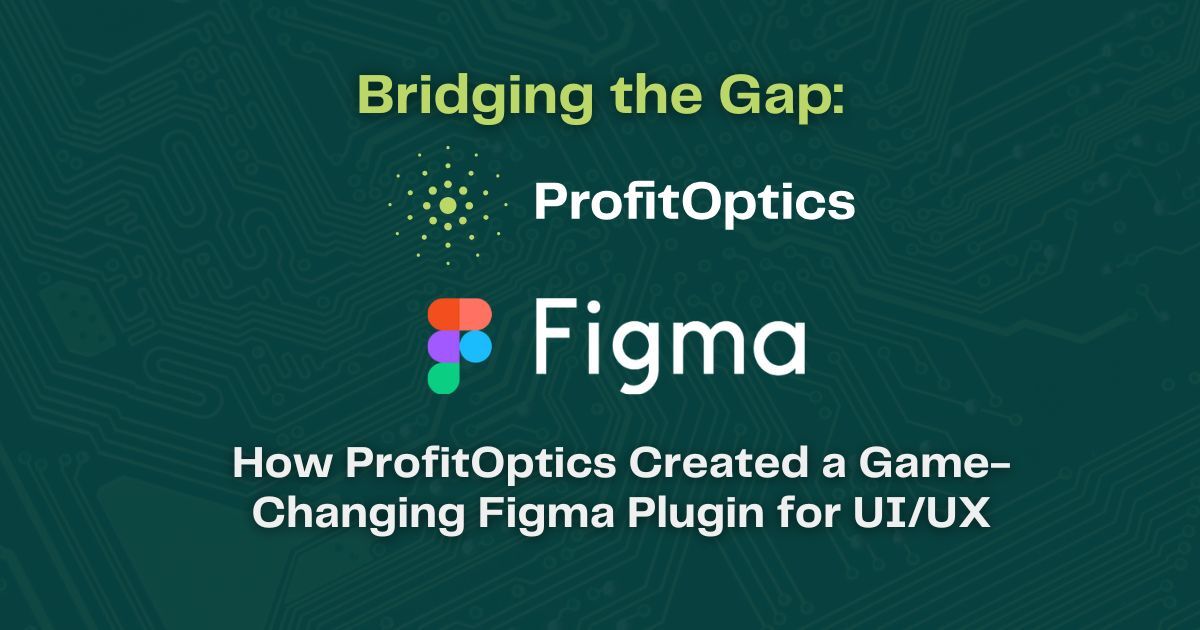
- A Common UI Challenge: ProfitOptics identified inefficiencies in exporting Figma designs into Material UI for front-end development.
- The Breakthrough Solution: ProfitOptics built a custom Figma plugin to automate UI consistency while allowing customization.
- Giving Back to the Community: The plugin is now open-source and available to developers worldwide, accelerating digital transformation in UI/UX.

At ProfitOptics, we believe that the best innovations often stem from unexpected challenges. When Lauren Thacker and Jeff Holloway encountered a major roadblock in UI development, they didn’t just solve the problem—they created a breakthrough solution that would benefit not just ProfitOptics but the broader software development community.
What started as an internal tool for streamlining front-end development has now evolved into a publicly available Figma plugin, enabling software teams to bridge the gap between design and development more efficiently than ever before.
In this interview, Lauren and Jeff share:
- How they identified a critical need in UI development
- The challenges they faced in building a custom Figma plugin
- Why they chose to open-source their solution to the community
- What this means for ProfitOptics and the future of digital transformation
Let’s dive into their journey and uncover how this game-changing innovation came to life.

About Lauren Thacker & Jeff Holloway
Lauren Thacker, Senior UI/UX Designer
Lauren is a senior UI/UX designer at ProfitOptics, specializing in human-centered design and front-end development. She has played a pivotal role in shaping ProfitOptics' White Glove Catalyst Design System, ensuring that software solutions are both functional and visually intuitive.
Jeff Holloway, Software Engineering Lead
Jeff is a seasoned software engineer and product strategist with expertise in digital transformation and scalable solutions. With a background in both back-end development and user experience, Jeff has helped drive ProfitOptics’ commitment to seamless, user-friendly software solutions.
The Interview
Q: What was the initial vision for this project?
Lauren: "The goal was to create a reusable and scalable design system that would speed up our front-end development process. We chose Material UI as our framework, but we ran into a significant problem—we couldn’t export our Figma files to code efficiently. Instead of settling for workarounds, we decided to build a custom Figma plugin that would solve this issue at its core."
Q: Was this solution originally built for a specific client?
Jeff: "Not at all. At ProfitOptics, we’ve focused heavily on back-end development and data-driven solutions. But as we expanded, we realized we needed to make our platforms more user-centric and scalable. With 40-50 clients using different versions of our Catalyst platform, we needed a way to standardize and customize UI components without sacrificing efficiency."
Q: What makes this solution unique compared to other design-to-code tools?
Lauren: "The key difference is that our plugin allows for UI consistency across multiple clients while enabling customization. It doesn’t force users into rigid templates. Instead, it lets teams adjust typography, colors, spacing, and component styles while keeping the core structure intact. This allows developers to maintain a consistent design system while giving clients the flexibility to make the platform feel like their own."
Q: What was the biggest challenge in building this tool?
Jeff: "Honestly, it was a journey full of highs and lows. We started with one framework (MUI Joy) but had to switch to another when it became unsupported. We even found an existing project from Material UI that had similar goals but was never completed—so we picked it up and built it out ourselves.
At times, it felt like every two weeks brought a new roadblock, but our team stayed persistent and collaborative throughout the process. That resilience is what led us to the solution we have today."
Q: The plugin is now available in the Figma Marketplace. How does this expand its value?
Lauren: "Originally, this was just meant to solve internal workflow challenges at ProfitOptics. But once we saw the potential, we realized that many other software teams face the same problem. That’s why we decided to release it for free to the community.
Jeff: "There’s a huge demand for better design-to-code solutions, and we’re not the only company facing these challenges. By making the plugin open-source, we can help other developers and designers while also gathering feedback to improve it further."
Q: Will ProfitOptics monetize this product in the future?
Jeff: "No, our goal isn’t to make money off this tool—it’s to contribute to the open-source community. We already received approval from Material UI to publish it in their public forum, and we’re working on a GitHub release so more teams can access it. This aligns with our values of authenticity and curiosity, which drive everything we do at ProfitOptics."
Q: What’s next for this tool? How do you see it evolving?
Lauren: "We plan to continue adding new features and expanding the plugin’s capabilities. Ideally, we want to push the boundaries of what design systems can do—not just exporting style elements but helping developers automate more front-end work so they can focus on complex problem-solving."
Jeff: "Exactly. It’s all about making sure our internal teams and the broader community can work faster and smarter without sacrificing quality."

Key Takeaways
- Bridging the gap between design & development: This plugin eliminates a common bottleneck in UI development, making design-to-code translation seamless.
- Scalability & consistency for clients: With this tool, ProfitOptics can maintain a unified design system while allowing each client to have a unique brand experience.
- Commitment to open-source innovation: By sharing this tool with the developer community, Lauren, Jeff, and their team are driving forward industry-wide change.
- ProfitOptics is leading in digital transformation: This project highlights how ProfitOptics continues to push boundaries, proving that innovation starts with identifying real-world pain points and solving them creatively.
Lauren and Jeff’s journey is a testament to the power of persistence, problem-solving, and teamwork. What started as an internal fix became a public innovation, and it’s just the beginning.
At ProfitOptics, we’re proud to foster an environment where curiosity drives action, and action leads to industry-changing solutions.
Want to try the plugin? Check it out on Figma Marketplace.
Have thoughts or feedback? Drop us a comment or reach out—we’d love to hear from you!

